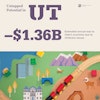Untapped Potential: Economic Impact of Childcare Breakdowns in the U.S.

High-quality childcare supports children's development and enables parents to advance professionally, boosting workforce productivity. When childcare systems fail, it hinders both children’s opportunities and parents’ participation in work or education, with significant economic consequences. Accessible, comprehensive childcare remains an urgent need.
The U.S. Chamber Foundation conducted studies in states across the country to better understand the impact of the childcare problem in their communities. The reports estimated that collectively, states lost billions of dollars in economic activity due to breakdowns in childcare.
Featured Reports
Untapped Potential: South Carolina
New research shows childcare gaps cost South Carolina nearly $1 billion each year in lost economic potential.
The Childcare Coverage Gap Challenging Economic Growth in Ohio
Ohio’s childcare gaps drive parents out of the workforce, reduce tax revenue for the state, and put undue strain on households.
How Childcare Impacts Indiana’s Workforce Productivity and Economy
Indiana's childcare gaps cost the state $4.22 billion annually, driving parents out of the workforce and hindering economic growth. This report highlights the urgent need for sustainable childcare solutions to support Indiana's families and unlock the state's full economic potential.
Examining Breakdowns in Care, Implications for the Economy
The U.S. Chamber Foundation partnered with the Florida Chamber Foundation to produce this report, which aims to address the unique needs of working parents in Florida by exploring the current childcare landscape.
State Reports
- Getting Working Parents Back to Work in MichiganThe U.S. Chamber Foundation partnered with the Grand Rapids Chamber, the Michigan Chamber of Commerce, and the Early Childhood Investment Corporation (ECIC) on this report, to understand the unique needs of working parents in Michigan by exploring the current childcare landscape.Read the Report
- Understanding the Impact on the Workforce and EducationThe U.S. Chamber Foundation partnered with the NC Chamber Foundation and NC Child to understand the unique needs of working parents in North Carolina.Read the Report
- Supporting Childcare Solutions to Unlock Economic PotentialThe U.S. Chamber of Commerce Foundation partnered with United Way of Salt Lake, Voices of Utah Children, and the Salt Lake Chamber of Commerce on this report to better understand the unique needs of working parents in Utah and examine the current childcare landscape.Read the Report
Untapped Potential in the News
Lack of affordable child care costs SC economy $1B annually, chamber study finds
Half of working South Carolina parents missed work at least once in three months for lack of child care. One in 10 reported quitting their job or getting fired, according to a survey by the state Chamber of Commerce.
Childcare Issues Lead to Annual $5 Billion Loss for Ohio’s Economy
Ohio’s lack of affordable childcare isn’t just hurting families — it’s costing the state’s economy nearly $5.5 billion in untapped taxes and employer earnings each year, according to the new report “Untapped Potential in Ohio.”
Missouri House Approves Child Care Tax Credit Bill
The Missouri House is one step closer to passing a bill that plans to incentivize childcare funding and help childcare providers.
Latest Content
- New research shows childcare gaps cost South Carolina nearly $1 billion each year in lost economic potential.The childcare coverage gap challenging economic growth.Indiana's childcare gaps cost the state $4.22 billion annually, driving parents out of the workforce and hindering economic growth. This report highlights the urgent need for sustainable childcare solutions to support Indiana's families and unlock the state's full economic potential.The U.S. Chamber Foundation partnered with the NC Chamber Foundation and NC Child to understand the unique needs of working parents in North Carolina.In the second installment of our Chamber Child Care Blog Series, Aaron explores how public-private partnerships across various states led to concrete initiatives that improved access to childcare.The U.S. Chamber of Commerce Foundation studies found that state economies lost between $100 million and $10 billion this year because of childcare issues.To find innovative solutions, we must build innovative partnerships. State and local chambers and Child Care Resource and Referral Agencies (CCR&Rs) can combine their respective expertise to implement childcare solutions that are specific to the needs of their communities.














